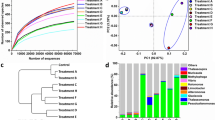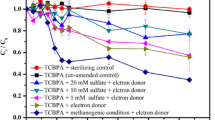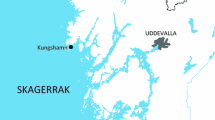Abstract
Four heterotrophic nitrifying bacteria—two Bacillus spp., an unidentified gram-positive rod and a gram-negative rod tentatively identified as a Pseudomonas sp.—were isolated from surficial sediments from Boston Harbor, Massachusetts. None of the organisms produced a detectable level of NO −3 . Nanomolar levels of tributyltin (TBT) and its degradation products dibutyltin (DBT) and monobutyltin (MBT) were examined for their effects on growth, NH +4 - uptake and N-oxidation by the organisms. TBT inhibited growth of all four isolates. DBT inhibited growth of Bacillus sp. SC-2 and the unidentified gram-positive rod. Growth of the Pseudomonas sp. was inhibited by exposure to 100 nM MBT. NH +4 uptake was inhibited, even by butyltin species that did not inhibit growth. Free NH2OH production and NO −2 production were inhibited by TBT but varied from being inhibited to being stimulated with different DBT or MBT exposure regimes. Nitrite production was affected differently from free NH2OH production for Bacillus sp. SC-2 and the unidentified rod. DBT appears to be particularly toxic to NH2OH oxidation by these four organisms. At the concentration used, TBT was more toxic than DBT or MBT. The results suggest that butyltins have the potential to affect nitrification by heterotrophic bacteria in the aquatic environment at nanomolar levels and that degradation of TBT to DBT and MBT does not necessary detoxify it.
Similar content being viewed by others
References
Aldridge WN, Brown AW (1988). The biological properties of methyl and ethyl derivatives of tin and lead. In: Craig PJ, Glocking F (eds) The biological alkylation of heavy metals. Royal Soc Chem, London, pp 147–163
Bock E, Koops H-P, Harms H (1986) Cell biology of nitrifying bacteria. In: Prosser JI (ed) Nitrification. IRL Press, Washington, DC, pp 17–38
Boopathy R, Daniels L (1991) Pattern of organotin inhibition of methanogenic bacteria. Appl Environ Microbiol 57:1189–1193
Brown CM (1988) Nitrate metabolism by aquatic bacteria. In: Austin B (ed) Methods in aquatic bacteriology. John Wiley and Sons, New York, pp 367–388
Cardwell BD, Sheldon AW (1986) A risk assessment concerning the fate and effects of tributyltins on the aquatic environment. Oceans 86 Proc, No 4, IEEE, Piscataway, NJ, pp 1117–1124
Castignetti D, Gunner HB (1980) Sequential nitrification by an Alcaligenes sp. and Nitrobacter agilis. Can J Microbiol 26:1114–1119
Castignetti D, Palutsis D, Turley J (1990) An examination of proton translocation and energy conservation during heterotrophic nitrification. FEMS Microbiol Lett 66:175–182
Cooney JJ, deRome L, Laurence O, Gadd GM (1989) Effects of organotin and organolead compounds on yeasts. J Ind Microbiol 4:279–288
Cooney JJ, Pettibone GW (1986) Metals and microbes in toxicity testing. Tox Assess 1:487–499
Cooney JJ, Weber JH, Sherman LR (1994) Tributyltins in aquatic ecosystems. In: Majumdar SK, Brenner FJ, Lovich JE, Miller EW, Schalles JF (ed) Biological diversity: Problems and challenges. Pennsylvania Acad Sci, Easton, PA, pp 123–135
Cooney JJ, Wuertz S (1989) Toxic effects of tin compounds on microorganisms. J Ind Microbiol 4:375–402
Csaky TZ (1948) On the estimation of bound hydroxylamine in biological materials. Acta Chem Scand 2:450–454
Doolittle M, Cooney JJ (1992) Inactivation of bacteriophage T4 by organic and inorganic tin compounds. J Ind Microbiol 10:221–228
Eng G, Tierney EJ, Bellama JM, Brinckman FE (1988) Correlation of molecular total surface area with organotin toxicity for biological and physiocochemical applications. Appl Organometal Chem 2:171–175
Focht DD, Verstraete W (1977) Biochemical ecology of nitrification and denitrification. In: Alexander M (ed) Adv microbial ecology. Plenum Press, NY, Vol 1, pp 135–214
Gerhardt P, Murray RGE, Costilow RN, Nester EW, Wood WA, Krieg NR, Phillips GB (1981) Manual of methods for general bacteriology. Amer Soc Microbiol, Washington, DC, 524 pp
Hall GH (1984) Measurement of nitrification rates in lake sediments: comparison of the nitrification inhibitors Nitrapyrin and allythiourea. Microbial Ecol 10:25–36
— (1986) Nitrification in lakes. In: Prosser JI (ed) Nitrification. Spec Pub Soc Gen Microbiol, IRL Press, Oxford, Vol 20, pp 127–156
Kaplan WA (1983) Nitrification. In: Carpenter EJ, Capone DG (eds) Nitrogen in the marine environment. Academic Press, NY, pp 139–190
Killham K (1986) Heterotrophic nitrification. In: Prosser JI (ed) Nitrification. IRL Press, Washington DC, pp 117–126
Kuenen JG, Robertson LA (1988) Ecology of nitrification and denitrification. In: Cole JA, Ferguson SJ (eds) The nitrogen and sulphur cycles. Cambridge Univ Press, Cambridge, pp 161–218
Laughlin RB, Jr, Johanessen RB, French W, Guard HE, Brinckman FE (1985) Structure-activity relationships for organotin compounds. Environ Toxicol Chem 4:343–351
MacFarlane GT, Herbert RA (1984) Dissimilatory nitrate reduction and nitrification in estuarine sediments. J Gen Microbiol 130:2301–2308
Maguire Rj, Tkacz RJ, Chau YK, Bengert GA, Wong PTS (1986) Occurrence of organotin compounds in water and sediment in Canada. Chemosphere 15:253–272
Makkar NS, Kronick AT, Cooney JJ (1989) Butyltins in sediments from Boston Harbor, USA. Chemosphere 18:2043–2050
Oehlmann J, Stroben E, Fiorini P (1991) The morphological expression of imposex in Nucella lapillus (Linnaeus) (Gastropoda: Muricidae). J Moll Stud 57:375–390
Oremland RS, Capone DG (1988) Use of “specific” inhibitors in biogeochemistry and microbial ecology. Adv Microbial Ecol 10:285–283
Papen H, vonBerg R, Hinkel I, Thoene B, Rennenberg H (1989) Heterotrophic nitrification by Alcaligenes faecalis: NO2−, NO3−, N20, and NO production in exponentially growing cultures. Appl Environ Microbiol 55:2068–2072
Robertson LA, Kuenen JG (1988) Heterotrophic nitrification in Thiosphaera pantotropha: Oxygen uptake and enzyme studies. J Gen Microbiol 134:857–863
Schimel JP, Firestone MK, Killham KS (1984) Identification of heterotrophic nitrification in a Sierra Forest soil. Appl Environ Microbiol 48:802–806
Spooner N, Gibbs PE, Bryan GW, Goad LJ (1991) The effect of tributyltin upon steroid titres in the female dogwhelk, Nucella lapillus, and the development of imposex. Mar Environ Res 32:37–49
Tate RL III (1977) Nitrification in histosols: A potential role for the heterotrophic nitrifier. Appl Environ Microbiol 33:911–914
Thompson JAJ, Sheffer MG, Pierce RC, Chau YK, Cooney JJ, Cullen WR, Maguire JR (1985) Organotin compounds in the aquatic environment. NRCC Assoc Comm Sci Criteria Environ Qual, Pub No NRCC 22494, National Research Council of Canada, Ottawa, Ontario, Canada 284 pp
Valkirs AO, Seligman PF, Lee RF (1986) Butyltin paritioning in marine waters and sediment. Oceans 86 Proc, vol 4, IEEE Service Center, Piscataway NJ, pp 1165–1170
Verstraete W, Alexander M (1972) Heterotrophic nitrification by Ārthrobacter sp. J Bacteriol 110:955–961
Vincent WF, Downes MT (1981) Nitrate in aerobic hypolimnia: relative importance of benthic and planktonic nitrifiers in an oligotrophic lake. Appl Environ Microbiol 42:565–573
Ward BB (1986) Nitrification in marine environments. In: Prosser JI (ed) Nitrification. Spec Pub Soc Gen Microbiol, IRL Press, Oxford, Vol 20, pp 157–184
Weber, G (1985) The importance of tin in the environment and its determination at three levels. Fresenius Z Anal chem 321:217–224
Wood PM (1986) Nitrification as a bacterial energy source. In: Prosser JI (ed) Nitrification. IRL Press, Washington, DC, pp 39–62
Author information
Authors and Affiliations
Rights and permissions
About this article
Cite this article
Miller, M.E., Cooney, J.J. Effects of Tri-, Di- and monobutyltin on heterotrophic nitrifying bacteria from surficial estuarine sediments. Arch. Environ. Contam. Toxicol. 27, 501–506 (1994). https://doi.org/10.1007/BF00214841
Received:
Revised:
Issue Date:
DOI: https://doi.org/10.1007/BF00214841




